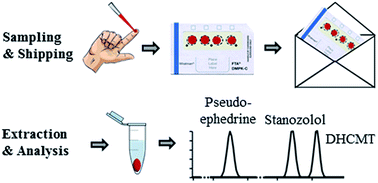Dried blood spots (DBS) in doping controls: a complementary matrix for improved in- and out-of-competition sports drug testing strategies
Abstract
A drop of whole blood dried on filter paper (Dried Blood Spots, DBS) represents an aspiring technique for minimally invasive sample collection in a multitude of analytical disciplines, e.g., therapeutic drug monitoring, preclinical drug development and diagnostic analysis of metabolic disorders in newborns. DBS sampling is characterized by cost-effectiveness, straightforwardness, robustness and facilitated storage and shipment conditions. The present investigation was conducted to highlight the opportunities arising from the implementation of DBS as a complementary matrix in doping control programs. Being frequently abused, three model compounds were chosen to represent the classes of anabolic agents (stanozolol and dehydrochloromethyltestosterone) and stimulants (pseudoephedrine). A quantitative method was developed and validated for the detection of the target analytes from DBS using liquid chromatography coupled to high resolution/high accuracy tandem mass spectrometry. The imprecision of the assay amounted to <8% for intraday and <18% for day-to-day measurements. Highly purified DBS sample extracts exhibited no ion suppression effects due to interfering matrix components and provided limits of detection of 20 pg mL−1 for stanozolol and 0.8 ng mL−1 for DHCMT and pseudoephedrine, respectively, notwithstanding an overall recovery of 26%. Deuterium-labeled internal standards were used to yield reliable quantitative results (accuracy 84–125%). The stability of the analytes was shown for at least 28 days at room temperature. The proof-of-principle for the method presented was substantiated by means of the analysis of authentic specimens obtained from administration studies with stanozolol, DHCMT and pseudoephedrine. The results provided, to the best of our knowledge, unprecedented detection windows for the tested anabolic agents accomplished by DBS sampling to support out-of-competition control efforts for the tested anabolic agents. Furthermore, the unambiguous proof of pharmacologically relevant blood concentrations at given urinary analyte levels is noteworthy for the improvement of in-competition controls, e.g., with regard to stimulant analysis.


 Please wait while we load your content...
Please wait while we load your content...